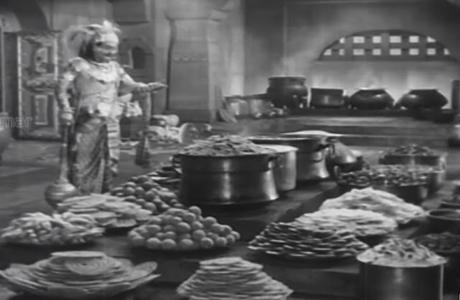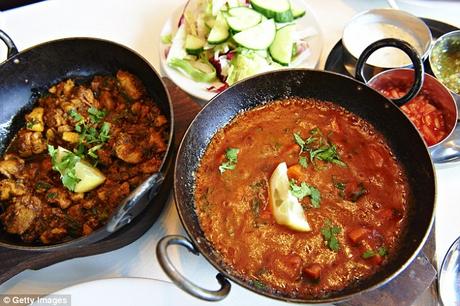 We
all like our food ~ none greater than a full mean served traditionally on
banana leaves, starting with banana, sweet, rice, many many varieties, ending
with curd rice. It is our tradition to
place a full /top leaf for guests [thalai vazhai]. Eating on banana leaves is a
custom that dates back thousands of years, however its benefits are still
relevant today. Madras has been home to
a network of hotels that serve pure vegetarian fare rooted in the Udupi region
of Karnataka. So the tagline ‘Udupi
Hotel’ became a benchmark for quality. Pulses
are a great tasting addition to any diet.
We have
many of them ~ then there are curries and if some one were to ask how old it is
? What would be your answer ? – do keep
your mind away from the food that is made in week-end and stored in your
refrigerator, getting served for a few days to come by ! Indians have been tucking into curries, dhals
and rice dishes since the Bronze Age, according to new research, and probably
even had takeaways. Ancient Indians used advanced farming techniques to bring
in rice, bean, lentils tuck into curries, dhal and rice dishes - around 5000
years ago. Archaeologists have discovered that rice was cultivated in India at
the same time farming techniques were developed in China, around 2800BC, and
400 years earlier than previously thought.
Indians
have been tucking into curries, dhals and rice dishes since the Bronze Age,
according to new research, and probably even had takeaways - not my version, but an article reproduced
from MailOnline of date.
Research discovered that the ancient Indus Civilisation, which streched
across what is now Pakistan and northwest India during the Bronze Age, had
massive cities of up to 40,000 people because their advanced farming techniques
meant they could grow surplus food and spices that would be traded at central
hubs. The new information confirms that the Indus people were the world's
earliest farmers, after they were previously thought to have learned rice
farming techniques from the Chinese.
The research also
confirms that Indus populations were the earliest people to use complex
multi-cropping strategies across both seasons, growing foods during summer, like
rice, millets and beans, before swapping to winter crops in the colder seasons
- like wheat and barley. Researchers from the University of Cambridge reckon a
network of regional farmers supplied assorted produce to the markets of the
civilisation's ancient cities. Study co-author Dr Jennifer Bates said: 'We
found evidence for an entirely separate domestication process in ancient South
Asia, likely based around the wild species Oryza nivara.
Archaeologists have
discovered that rice was cultivated in India at the same time farming
techniques were developed in China, around 2800BC, and 400 years earlier than
previously thought - 'This led to the local development of a mix of 'wetland'
and 'dryland' agriculture of local Oryza sativa indica rice agriculture before
the truly 'wetland' Chinese rice, Oryza sativa japonica, arrived around 2000
BC. 'While wetland rice is more productive, and took over to a large extent
when introduced from China, our findings appear to show there was already a
long-held and sustainable culture of rice production in India as a widespread
summer addition to the winter cropping during the Indus civilization.' Evidence
for very early rice was discovered at a site in the central Ganges basin, but
it has long been thought that domesticated rice agriculture did not reach South
Asia until towards the end of the Indus era, when the wetland rice arrived from
China around 2000 BC. But researchers found evidence of domesticated rice in
South Asia as much as 430 years earlier, making them the earliest farmers.
We
all like our food ~ none greater than a full mean served traditionally on
banana leaves, starting with banana, sweet, rice, many many varieties, ending
with curd rice. It is our tradition to
place a full /top leaf for guests [thalai vazhai]. Eating on banana leaves is a
custom that dates back thousands of years, however its benefits are still
relevant today. Madras has been home to
a network of hotels that serve pure vegetarian fare rooted in the Udupi region
of Karnataka. So the tagline ‘Udupi
Hotel’ became a benchmark for quality. Pulses
are a great tasting addition to any diet.
We have
many of them ~ then there are curries and if some one were to ask how old it is
? What would be your answer ? – do keep
your mind away from the food that is made in week-end and stored in your
refrigerator, getting served for a few days to come by ! Indians have been tucking into curries, dhals
and rice dishes since the Bronze Age, according to new research, and probably
even had takeaways. Ancient Indians used advanced farming techniques to bring
in rice, bean, lentils tuck into curries, dhal and rice dishes - around 5000
years ago. Archaeologists have discovered that rice was cultivated in India at
the same time farming techniques were developed in China, around 2800BC, and
400 years earlier than previously thought.
Indians
have been tucking into curries, dhals and rice dishes since the Bronze Age,
according to new research, and probably even had takeaways - not my version, but an article reproduced
from MailOnline of date.
Research discovered that the ancient Indus Civilisation, which streched
across what is now Pakistan and northwest India during the Bronze Age, had
massive cities of up to 40,000 people because their advanced farming techniques
meant they could grow surplus food and spices that would be traded at central
hubs. The new information confirms that the Indus people were the world's
earliest farmers, after they were previously thought to have learned rice
farming techniques from the Chinese.
The research also
confirms that Indus populations were the earliest people to use complex
multi-cropping strategies across both seasons, growing foods during summer, like
rice, millets and beans, before swapping to winter crops in the colder seasons
- like wheat and barley. Researchers from the University of Cambridge reckon a
network of regional farmers supplied assorted produce to the markets of the
civilisation's ancient cities. Study co-author Dr Jennifer Bates said: 'We
found evidence for an entirely separate domestication process in ancient South
Asia, likely based around the wild species Oryza nivara.
Archaeologists have
discovered that rice was cultivated in India at the same time farming
techniques were developed in China, around 2800BC, and 400 years earlier than
previously thought - 'This led to the local development of a mix of 'wetland'
and 'dryland' agriculture of local Oryza sativa indica rice agriculture before
the truly 'wetland' Chinese rice, Oryza sativa japonica, arrived around 2000
BC. 'While wetland rice is more productive, and took over to a large extent
when introduced from China, our findings appear to show there was already a
long-held and sustainable culture of rice production in India as a widespread
summer addition to the winter cropping during the Indus civilization.' Evidence
for very early rice was discovered at a site in the central Ganges basin, but
it has long been thought that domesticated rice agriculture did not reach South
Asia until towards the end of the Indus era, when the wetland rice arrived from
China around 2000 BC. But researchers found evidence of domesticated rice in
South Asia as much as 430 years earlier, making them the earliest farmers.
 The new research is
published today in the journals Antiquity and Journal of Archaeological Science
by researchers from the University of Cambridge's Division of Archaeology, in
collaboration with colleagues at Banaras Hindu University and the University of
Oxford. Co-author Dr Cameron Petrie says that the location of the Indus in a
part of the world that received both summer and winter rains may have
encouraged the development of seasonal crop rotation, way before other major
civilisations of the time, such as Ancient Egypt and China's Shang Dynasty.
The archaeologists
sifted for traces of ancient grains in the remains of several Indus villages
within a few kilometers of the site called Rakhigari. They reckon their
advanced farming techniques meant the Indus civilization could support cities
with massive populations of up to 40,000 people. They used radiocarbon dating
to provide the first absolute dates for Indus multi-cropping, discovering they
began growing them around 2890-2630 BC for millets and winter pulses, and
2430-2140 BC for rice. Urad beans, however, are a relative of the mung bean,
often used in popular types of Indian dhal today. The variety of crops may have
been transported to the cities, which would suggest that there was some sort of
bartering system in place for people to trade services for food - like
modern-day takeaways. Urban hubs may have served as melting pots for produce
from regional growers, as well as meats and spices, and evidence for spices
have been found elsewhere in the Rakhigarhi region.
Dr Bates said: 'It
is certainly possible that a sustainable food economy across the Indus zone was
achieved through growing a diverse range of crops, with choice being influenced
by local conditions. 'It is also possible that there was trade and exchange in
staple crops between populations living in different regions, though this is an
idea that remains to be tested.' Dr Petrie added: 'Such a diverse system was
probably well suited to mitigating risk from shifts in climate. 'It may be that
some of today's farming monocultures could learn from the local crop diversity
of the Indus people 4,000 years ago.'
With regards – S.
Sampathkumar
22nd
Nov. 2016.
The new research is
published today in the journals Antiquity and Journal of Archaeological Science
by researchers from the University of Cambridge's Division of Archaeology, in
collaboration with colleagues at Banaras Hindu University and the University of
Oxford. Co-author Dr Cameron Petrie says that the location of the Indus in a
part of the world that received both summer and winter rains may have
encouraged the development of seasonal crop rotation, way before other major
civilisations of the time, such as Ancient Egypt and China's Shang Dynasty.
The archaeologists
sifted for traces of ancient grains in the remains of several Indus villages
within a few kilometers of the site called Rakhigari. They reckon their
advanced farming techniques meant the Indus civilization could support cities
with massive populations of up to 40,000 people. They used radiocarbon dating
to provide the first absolute dates for Indus multi-cropping, discovering they
began growing them around 2890-2630 BC for millets and winter pulses, and
2430-2140 BC for rice. Urad beans, however, are a relative of the mung bean,
often used in popular types of Indian dhal today. The variety of crops may have
been transported to the cities, which would suggest that there was some sort of
bartering system in place for people to trade services for food - like
modern-day takeaways. Urban hubs may have served as melting pots for produce
from regional growers, as well as meats and spices, and evidence for spices
have been found elsewhere in the Rakhigarhi region.
Dr Bates said: 'It
is certainly possible that a sustainable food economy across the Indus zone was
achieved through growing a diverse range of crops, with choice being influenced
by local conditions. 'It is also possible that there was trade and exchange in
staple crops between populations living in different regions, though this is an
idea that remains to be tested.' Dr Petrie added: 'Such a diverse system was
probably well suited to mitigating risk from shifts in climate. 'It may be that
some of today's farming monocultures could learn from the local crop diversity
of the Indus people 4,000 years ago.'
With regards – S.
Sampathkumar
22nd
Nov. 2016.
Source : http://www.dailymail.co.uk/news/article-3955780/World-s-curry-5-000-years-ago-Indians-eating-national-dish-Bronze-Age.html

